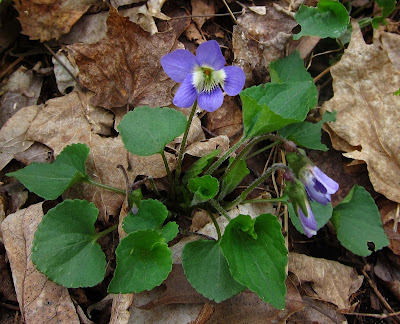Violets here! Violets there! Violets everywhere! Who doesn't love violets (aside from grass-lawn fanatics)? No matter which species they are, they are all beautiful. As their name suggests, the ones we are most likely to see in most places are Common Blue Violets, like these that were covering a bank in the Yaddo Garden yesterday.

Common Blue Violets used to go by the scientific name of Viola papilionacea, but recent taxonomic research has reclassified them as V. sororia, a species now also shared by two other violets, the Broad-leaved Wood Violet and the Wooly Blue. I first found a Wooly Blue Violet last spring, and I was most excited, believing I had discovered a new flower for my life list. And in truth, I did, no matter what the taxonomists say. See how this looks at first glance just like the Common Blue?
Well, a closer inspection reveals some very wooly stems (and wooly leaves, too, which aren't visible in this photo). Ordinary Common Blues have smooth stems and leaves.
At first, I thought I may have found a Northern Blue Violet (V. septentrionalis), another species with wooly stems and leaves, but a peek at my violet's petals revealed that its lower petal was smooth, not hairy like those of the Northern Blue. So Wooly it was, instead. V. sororia. Same species as the Common Blue, but to me it will always be a different violet.
Near where I found that Wooly Blue were these beautiful Canada Violets (V. canadensis), which I could identify from afar by the purple color of the buds and the snowy white faces of the open flowers. A closer inspection would reveal that leaves and flowers share the same stems, another characteristic of this "stemmed" species. The blues I mentioned above have only basal leaves, with flowers on a separate stalk.
Another distinguishing feature of V. canadensis is its deep yellow center.
Also, the backs of those pristine white blooms are almost always tinged with purple.
Here's another white violet, and I'm not sure which species it is: Northern White (V. pallens) or Sweet White (V. blanda). Both are basal-leaved, small, white, and fragrant.
 The two species share so many traits in common that I usually tell them apart by habitat and bloom time, with V. pallens liking wetter spots and usually blooming several weeks earlier than V. blanda. But this spring, with so many flowers blooming all at once, the timing clue doesn't hold true. And habitats overlap. These were growing out on a big lawn. A kind of damp big lawn. Are those upper petals bent backward (another trait of V. blanda)? Oh Jeez, I can't tell! All I know is, it's one or the other. And lovely!
The two species share so many traits in common that I usually tell them apart by habitat and bloom time, with V. pallens liking wetter spots and usually blooming several weeks earlier than V. blanda. But this spring, with so many flowers blooming all at once, the timing clue doesn't hold true. And habitats overlap. These were growing out on a big lawn. A kind of damp big lawn. Are those upper petals bent backward (another trait of V. blanda)? Oh Jeez, I can't tell! All I know is, it's one or the other. And lovely!Here's another one of those "stemmed" violets, Downy Yellow Violet (V. pubescens), just coming into bloom now in the Skidmore Woods.

As its name implies, its stem is hairy, as are the undersides of its leaves. There is a smooth variety of this violet, one that used to have a species of its own (V. pensylvanica), but is now considered a variety rather than a separate species. Its new name is V. pubescens var. scabriuscula. Oof! Quite a mouthful for such a pretty little flower.
I know I posted a photo of these Long-spurred Violets a few days ago, but they are so very pretty, with their deep-purple centers and perky spurs, I wanted to see them again. Besides, I didn't give their scientific name last time. It's V. rostrata. Same as it's always been.







4 comments:
Hi, Jackie. I've been following your blog for a little while now, and I have to say, I love it. And thank you so much for this post -- I'm just starting to learn to recognize different species of violets this spring here in Connecticut, and your pictures and descriptions are immensely helpful. (And I'm glad to see that I'm not alone in having trouble telling Sweet White and Northern White Violets apart. :P) Thanks again!
Nice post! I've been really honing in and focusing on the numerous Violas of Ohio this spring. So far I'm at 15 species with a few more to go! I plan on doing a Violet mega-post sometime in the near future :)
Thanks for your comment, Elizabeth, which (by clicking on your name) gave us access to your own fascinating blog about nature there in CT. We sure could drive ourselves crazy trying to ID all the violets, couldn't we? I have to remind myself sometimes to just relax and enjoy their beauty.
Can't wait to see your violet post, A.L. , especially if it will be like the other wonderful entries you post on your blog about the natural treasures of Ohio.
So...I guess my cry - Oh look violets! Doesn't cut it! ;->
That you outlined a process of identification is so helpful -
Thanks, as always!
@Elizabeth - I'm going to check out your blog right now! :-)
Post a Comment